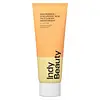What's inside
What's inside
 Key Ingredients
Key Ingredients

 Benefits
Benefits

 Concerns
Concerns

 Ingredients Side-by-side
Ingredients Side-by-side

Water
Skin ConditioningGlycerin
HumectantIsopropyl Palmitate
EmollientStearic Acid
CleansingDihydroxyacetone
Skin ConditioningDimethicone
EmollientGlycol Stearate
EmollientPEG-100 Stearate
Caprylyl Glycol
EmollientCaramel
Cosmetic ColorantCetyl Alcohol
EmollientCitric Acid
BufferingDimethiconol
EmollientDisodium EDTA
Glyceryl Stearate
EmollientHydroxyethyl Acrylate/Sodium Acryloyldimethyl Taurate Copolymer
Emulsion StabilisingHydroxystearic Acid
CleansingIsohexadecane
EmollientIsopropyl Myristate
EmollientMaltodextrin
AbsorbentPalmitic Acid
EmollientParfum
MaskingPhenoxyethanol
PreservativePolysorbate 60
EmulsifyingSodium Hydroxypropyl Starch Phosphate
AbrasiveSorbitan Isostearate
EmulsifyingStearamide Amp
Alpha-Isomethyl Ionone
PerfumingBenzyl Alcohol
PerfumingButylphenyl Methylpropional
PerfumingCitronellol
PerfumingCoumarin
PerfumingGeraniol
PerfumingHexyl Cinnamal
PerfumingLimonene
PerfumingLinalool
PerfumingCI 16255
Cosmetic ColorantCI 47005
Cosmetic ColorantWater, Glycerin, Isopropyl Palmitate, Stearic Acid, Dihydroxyacetone, Dimethicone, Glycol Stearate, PEG-100 Stearate, Caprylyl Glycol, Caramel, Cetyl Alcohol, Citric Acid, Dimethiconol, Disodium EDTA, Glyceryl Stearate, Hydroxyethyl Acrylate/Sodium Acryloyldimethyl Taurate Copolymer, Hydroxystearic Acid, Isohexadecane, Isopropyl Myristate, Maltodextrin, Palmitic Acid, Parfum, Phenoxyethanol, Polysorbate 60, Sodium Hydroxypropyl Starch Phosphate, Sorbitan Isostearate, Stearamide Amp, Alpha-Isomethyl Ionone, Benzyl Alcohol, Butylphenyl Methylpropional, Citronellol, Coumarin, Geraniol, Hexyl Cinnamal, Limonene, Linalool, CI 16255, CI 47005
Water
Skin ConditioningHelianthus Annuus Seed Oil
EmollientGlycerin
HumectantNiacinamide
SmoothingButyrospermum Parkii Butter
Skin ConditioningC15-19 Alkane
SolventCaprylic/Capric Triglyceride
MaskingCetearyl Alcohol
EmollientGlyceryl Stearate
EmollientCetyl Alcohol
EmollientPEG-100 Stearate
Squalane
EmollientPanthenol
Skin ConditioningHippophae Rhamnoides Fruit Extract
Skin ConditioningSodium Hyaluronate
HumectantPantolactone
HumectantLactic Acid
BufferingPotassium Sorbate
PreservativeSodium Benzoate
MaskingPhenoxyethanol
PreservativeEthylhexylglycerin
Skin ConditioningCitric Acid
BufferingWater, Helianthus Annuus Seed Oil, Glycerin, Niacinamide, Butyrospermum Parkii Butter, C15-19 Alkane, Caprylic/Capric Triglyceride, Cetearyl Alcohol, Glyceryl Stearate, Cetyl Alcohol, PEG-100 Stearate, Squalane, Panthenol, Hippophae Rhamnoides Fruit Extract, Sodium Hyaluronate, Pantolactone, Lactic Acid, Potassium Sorbate, Sodium Benzoate, Phenoxyethanol, Ethylhexylglycerin, Citric Acid
Ingredients Explained
These ingredients are found in both products.
Ingredients higher up in an ingredient list are typically present in a larger amount.
Cetyl Alcohol is a fatty alcohol. Fatty Alcohols are most often used as an emollient or to thicken a product.
Its main roles are:
Though it has "alcohol" in the name, it is not related to denatured alcohol or ethyl alcohol.
The FDA allows products labeled "alcohol-free" to have fatty alcohols.
Learn more about Cetyl AlcoholCitric Acid is an alpha hydroxy acid (AHA) naturally found in citrus fruits like oranges, lemons, and limes.
Like other AHAs, citric acid can exfoliate skin by breaking down the bonds that hold dead skin cells together. This helps reveal smoother and brighter skin underneath.
However, this exfoliating effect only happens at high concentrations (20%) which can be hard to find in cosmetic products.
Due to this, citric acid is usually included in small amounts as a pH adjuster. This helps keep products slightly more acidic and compatible with skin's natural pH.
In skincare formulas, citric acid can:
While it can provide some skin benefits, research shows lactic acid and glycolic acid are generally more effective and less irritating exfoliants.
Most citric acid used in skincare today is made by fermenting sugars (usually from molasses). This synthetic version is identical to the natural citrus form but easier to stabilize and use in formulations.
Read more about some other popular AHA's here:
Learn more about Citric AcidGlycerin is already naturally found in your skin. It helps moisturize and protect your skin.
A study from 2016 found glycerin to be more effective as a humectant than AHAs and hyaluronic acid.
As a humectant, it helps the skin stay hydrated by pulling moisture to your skin. The low molecular weight of glycerin allows it to pull moisture into the deeper layers of your skin.
Hydrated skin improves your skin barrier; Your skin barrier helps protect against irritants and bacteria.
Glycerin has also been found to have antimicrobial and antiviral properties. Due to these properties, glycerin is often used in wound and burn treatments.
In cosmetics, glycerin is usually derived from plants such as soybean or palm. However, it can also be sourced from animals, such as tallow or animal fat.
This ingredient is organic, colorless, odorless, and non-toxic.
Glycerin is the name for this ingredient in American English. British English uses Glycerol/Glycerine.
Learn more about GlycerinGlyceryl Stearate is a mix of glycerin and stearic acid.
It is used to stabilize the mixing of water and oil ingredients. By preventing these ingredients from separating, it can help elongate shelf life. It can also help thicken the product's texture.
As an emollient, it helps soften skin and supports barrier-replenishing ingredients.
In cosmetics, Glyceryl Stearate is often made from vegetable oils or synthetically produced.
This ingredient may not be fungal-acne safe
Fun fact: The human body also creates Glyceryl Stearate naturally.
Learn more about Glyceryl StearatePeg-100 Stearate is an emollient and emulsifier. As an emollient, it helps keep skin soft by trapping moisture in. On the other hand, emulsifiers help prevent oil and water from separating in a product.
PEGS are a hydrophilic polyether compound . There are 100 ethylene oxide monomers in Peg-100 Stearate. Peg-100 Stearate is polyethylene glycol ester of stearic acid.
Phenoxyethanol is a preservative that has germicide, antimicrobial, and aromatic properties. Studies show that phenoxyethanol can prevent microbial growth. By itself, it has a scent that is similar to that of a rose.
It's often used in formulations along with Caprylyl Glycol to preserve the shelf life of products.
Water. It's the most common cosmetic ingredient of all. You'll usually see it at the top of ingredient lists, meaning that it makes up the largest part of the product.
So why is it so popular? Water most often acts as a solvent - this means that it helps dissolve other ingredients into the formulation.
You'll also recognize water as that liquid we all need to stay alive. If you see this, drink a glass of water. Stay hydrated!
Learn more about Water